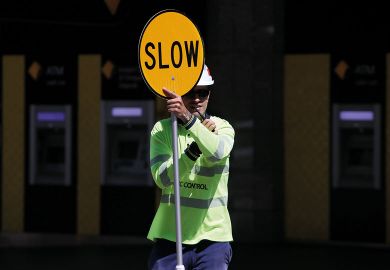When a commercial administrator at a Buenos Aires import-export company applied for a six-month visa to hone his language skills at Lexis English in Australia, the “guaranteed” job awaiting him on his return home did not convince the officials that he would leave after finishing his course.
“I give more weight to…the applicant’s potential economic circumstances in Colombia,” the rejection letter says. “The applicant implied a career pathway intention in Colombia [but]…I am not satisfied that the course would result in the claimed employment benefits in Colombia.”
Lexis managing director Ian Pratt said the repeated references to the Argentinian applicant’s Colombian homeland were a clear “cut-and-paste” error, with the correspondence containing identical paragraphs to many other rejection letters.
“We see them get the name of the student wrong. We see them get the name of the school wrong. I suspect…you’ve got some poor guy sitting there who’s inadequately trained and rushed, making bad decisions quickly.”
The A$710 (£366) application fees students must pay for this “grossly inadequate” service is roughly equivalent to three weeks’ average salary for an Argentinian, or five weeks for a Colombian. Mr Pratt said he could not “fathom” private companies treating clients in this way.
“Perfectly eligible students who’ve done everything right are being refused on what appears to be a whim. They’re making the biggest decision of their life to travel to Australia. They’ve saved up for years. [Our] government…tells us that they’re trying to protect students being abused by our sector. By far the worst abuser of students is our government.”
Its approach could backfire economically, after international education earned the country about A$48 billion last year, surpassing the 2019 record by almost A$8 billion.
Australian Bureau of Statistics figures suggest that the industry could be preventing Australia’s tepid economy lapsing into recession. The A$3.1 billion growth in gross domestic product over the third and fourth quarters of 2023 was eclipsed by the A$3.4 billion increase in spending by foreign students.
The Department of Home Affairs says all visa applications are “assessed on merits of the individual cases” against publicly disclosed legal requirements. College principals and vice-chancellors say the “bewildering” rejections suggest otherwise.
Mr Pratt said neighbouring countries with “identical risk profiles” were attracting vastly different grant rates, while schools with different risk assessment levels were attracting similar grant rates. “We were told that schools with a better assessment level would receive preferential treatment. It’s not the case.
“The students haven’t changed. We haven’t changed. The system has changed. And the government hasn’t told us what they’ve changed it to.”
He said the most common grounds for refusal was that Australia’s high wages were a “disincentive” for students to leave. “On that basis, they can refuse an application from every country except Norway and Switzerland. It’s the classic cover-all.”
Mr Pratt said it was too early to tell whether the crisis would match the “perfect storm” 15 years ago, when private college enrolments were undermined by the combined impacts of regulatory change, violence against students and a soaring Australian dollar.
But universities would feel the impacts this time around, partly because of the government’s proposal to boost English language requirements to an “extremely challenging” level for students from regions such as Latin America.
“They’re going to require pre-training,” he said. “But they’re far from assured of a visa even [to study] English.”
Register to continue
Why register?
- Registration is free and only takes a moment
- Once registered, you can read 3 articles a month
- Sign up for our newsletter
Subscribe
Or subscribe for unlimited access to:
- Unlimited access to news, views, insights & reviews
- Digital editions
- Digital access to THE’s university and college rankings analysis
Already registered or a current subscriber?








